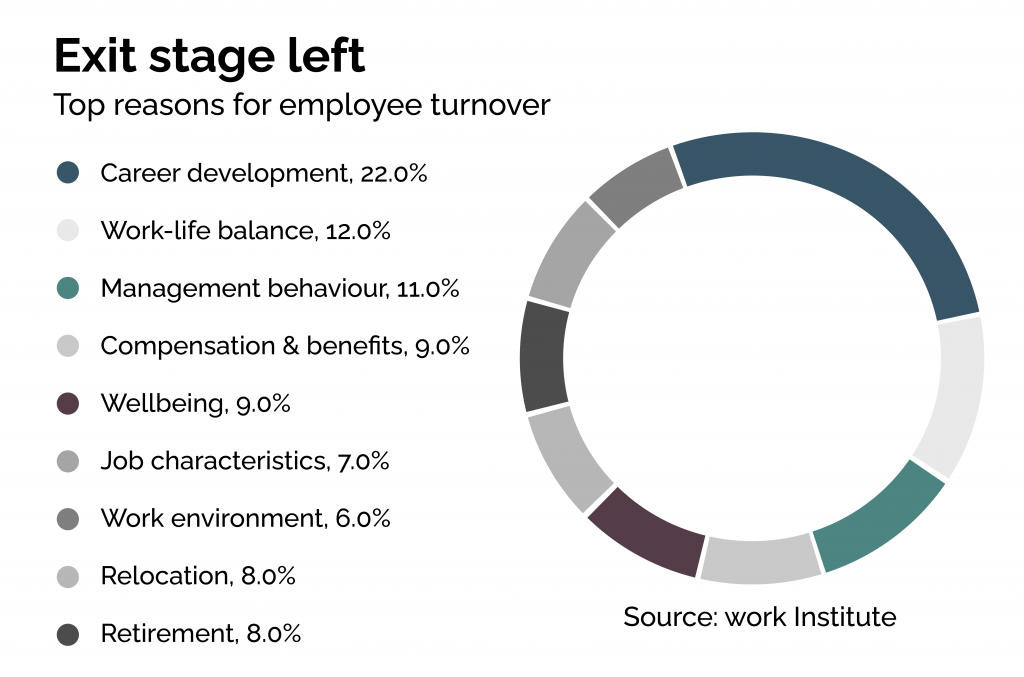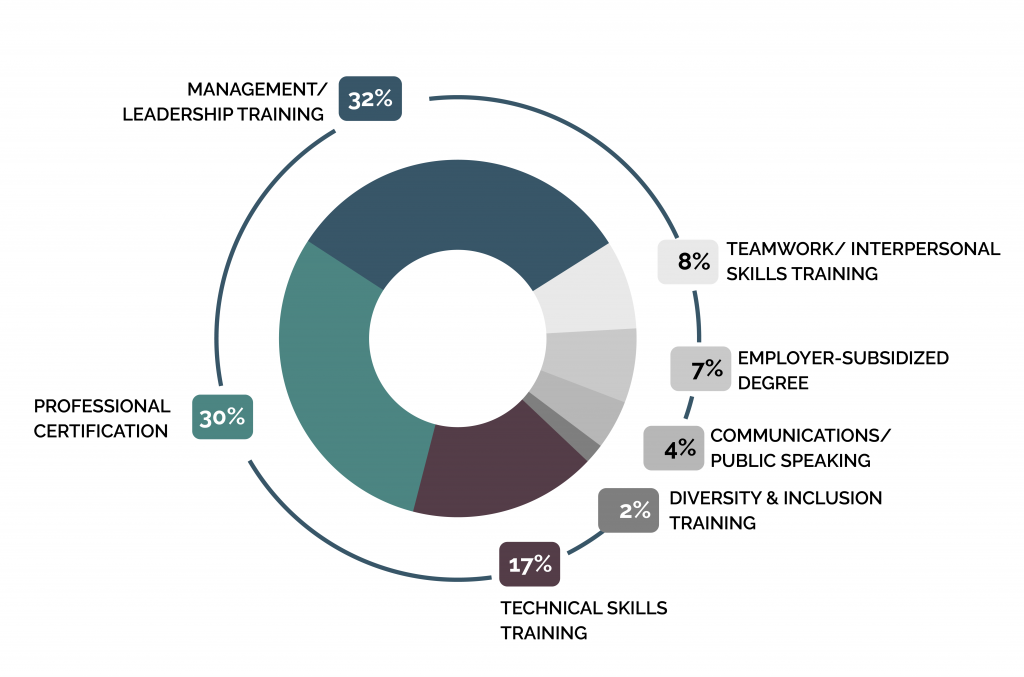In the continuously changing workspace, recruiting and retaining top employees is more crucial than ever. According to the Bureau of Labor Statistics 2020 Job Openings and Labor Turnover Survey (JOLTS), the overall voluntary turnover rate from December 2019 to December 2020 was 19.9%. This rate has steadily increased over the last decade. As the turnover rate increases, the cost of employee turnover also reaches new heights. The Work Institute’s 2017 Retention Report states that turnover can cost employers an average of 33% of an employee’s annual salary due to recruiting, interviewing, onboarding, and initial training costs (Sears, 2017).
How are companies supposed to recruit the right personnel, and then what do companies need to encourage recruits to be long-term employees? The clear answer is increasing training and development opportunities for employees to decrease turnover intentions. According to the EXECU Search Group report from 2019, 86% of professionals said they would change jobs if offered more professional development opportunities. Also, the top reported reason employees gave for leaving their position was lack of career development opportunities, as shown in the graphic below from the Work Institute’s 2017 Retention Report. This reason is nearly double the second most reported reason, lack of work-life balance.

Similar to turnover intentions, 43% of the variance in organization commitment can be explained by an organizational learning culture (Joo, 2010). When organizations offer growth and developmental opportunities, such as training and further education, employees feel their employment is valued, that their current and future abilities are trusted, and that the company wants to continue their development (Mustafa & Ali, 2019). This can be further explained through the basis of social exchange theory (Blau, 1964) which says when employees feel their organizations value them as essential resources and care about their professional and long-term development, they are more likely to be engaged and diligently work for the organization to fulfill the reciprocal relationship exchange (Raza, Ali, Naseem, Moeed, Ahmed, & Hamid, 2018).
Studies are ongoing concerning the availability of learning and development opportunities for employees and their influence on different workplace outcomes, including organizational commitment, well-being, employee engagement, job satisfaction, role performance, and turnover intentions. The following sections provide current research and statistics relating to the learning opportunities studies.
Employee Emotional Exhaustion
Emotional exhaustion is a chronic state of fatigue characterized by physical and mental depletion due to workplace demands and stressors. Related turnover intentions are the deliberate and conscious effort to leave an organization for other opportunities or personal/professional concerns (Raza et al., 2018). According to Proost, Ruysseveldt, and Dijke, learning opportunities positively affect knowledge and skill acquisition and provide opportunities for “skill utilization, job enhancement, and professional growth” (2012). In addition, these opportunities help employees realize their goals and “adequately manage the physiological and psychological demands they encounter in their jobs” (2012), which decreases emotional exhaustion and related turnover intentions.
Employee Expectations
Increasing learning opportunities also help reduce early-stage turnover due to unmet expectations about one’s position. For example, the 2012 Proost, Ruysseveldt, and Dijke study report the relationship between unmet expectations and turnover intentions are stronger when learning opportunities are low (b = .21) (i.e., one standard deviation below the mean) and weaker when learning opportunities are high (b = .08) (i.e., one standard deviation above the norm). This clearly shows how increasing learning opportunities can decrease turnover intentions.
Employee Engagement
Learning opportunities can reduce negative workplace tendencies and increase employee performance/engagement and extra-role behaviors. Employee engagement is the state of mind held by positive and encouraged employees characterized by vigor, enthusiasm, dedication, and absorption (Eldor & Harpaz, 2016). Extra-role behaviors define exceptional employees—proactivity, knowledge sharing, creativity, and adaptivity (Eldor & Harpaz, 2016). In one study, 625 employees were surveyed on employee engagement, extra-role performance, job satisfaction, and perceived level of learning. The study found that the relationship between perceived learning climate and employee engagement was strong, positive, and significant (r = 0.52, p≤0.001), as were the relationships between employee engagement and all four performance variables: proactivity (r = 0.35, p≤0.001), knowledge sharing (r = 0.38, p≤0.001), creativity (r = 0.49, p≤0.001), and adaptivity (r = 0.44. p≤0.001) (Eldor & Harpaz, 2016). This data reveals that organizations promoting learning opportunities reduce turnover and increase employee engagement and performance—these benefit employee satisfaction with their position and the organization.
Job Satisfaction
Finally, learning opportunities show one of the most potent effects on overall employee job satisfaction. Job satisfaction is one of the critical determinants of turnover intentions. It can be described as the perception of one’s job expectancies and job reality and whether those expectancies are being met. Research shows that employees who feel more satisfied within their position and organization are more likely to become engaged employees and display lower turnover intentions (Lin & Huang, 2020). In addition, organizations that prioritize learning and development found increased employee job satisfaction, productivity, and profitability (Egan, Yang, & Barlett, 2004). Several studies on this topic show conclusive results. One study tested different forms of learning against employee satisfaction and employee turnover intentions and found that all types of learning (individual learning (γ=0.41, p<0.001), collective learning (γ=0.42, p<0.05), organization-level understanding (γ=0.40, p<0.01), inter-organizational learning (γ=0.45, p<0.01), and exploration learning (γ=0.44, p<0.01)) correlated positively and significantly to employee satisfaction and correlated negatively and significantly to turnover intentions. This shows that learning opportunities, in any form, are highly valued by employees regarding job satisfaction and can reduce an employee’s turnover intentions.
Desired Learning Opportunities
These studies show that learning and development opportunities should not be underestimated in the scope of organizational success, both in reducing turnover and the increase of positive employee behaviors. Beyond understanding that employees desire training and learning opportunities from their organizations, it is imperative to understand what topics they want. PayScale’s 2019 Compensation Best Practices Report surveyed 38,000 respondents who were asked to indicate which professional development opportunities they enjoyed the most from their organization. Shown in the graphic below are the top seven categories of training and development from the survey. The principal learning opportunity wanted to be selected by 32% of respondents in management/leadership training. A close second, chosen by 30% of respondents, is professional certification. Additional training included in the top seven are technical skills (17%), teamwork and interpersonal skills (8%), employer-subsidized degree (7%), communications/public speaking (4%), and diversity and inclusion (2%).
 Conclusion
Conclusion
Radiant Digital specializes in custom content creation to suit your unique organizational needs and to learn objectives if you’re looking to increase your organization’s learning and development opportunities. It can be hard to know exactly where to start when creating a learning-focused culture. Radiant can assist you in the design, development, and implementation of learning programs so you can achieve your highest organizational goals. Reach out to us today to see how we can help.
Citations
2019 Compensation Best Practices Report. PayScale. (n.d.). Retrieved from https://www.payscale.com/data/professional-development-employees-want.
Bureau of Labor Statistics, U.S. Department of Labor (2020). 2020 Job Openings and Labor Turnover Survey. Received from https://www.bls.gov/opub/mlr/2021/article/as-the-covid-19-pandemic-affects-the-nation-hires-and-turnover-reach-record-highs-in-2020.htm
Egan, T., Yang, B., & Bartlett, K. (2004). The effects of organizational learning culture and job satisfaction on motivation to transfer learning and turnover intention. Human Resource Development Quarterly, 15, 279-301.
Joo, B. (2010). Organizational commitment for knowledge workers: The roles of perceived organizational learning culture, leader-member exchange quality, and turnover intention. Human Resource Development Quarterly, 21. 69 – 85. 10.1002/hrdq.20031.
Lin, C. Y., & Huang, C. K. (2020). Employee turnover intentions and job performance from a planned change: The effects of an organizational learning culture and job satisfaction. International Journal of Manpower, 42. 409-423. 10.1108/IJM-08-2018-0281.
Mustafa, G., & Ali, N. (2019) Rewards, autonomous motivation, and turnover intention: Results from a non-Western cultural context, Cogent Business & Management, 6:1, 1676090, DOI: 10.1080/23311975.2019.1676090.
Proost, K., Ruysseveldt, J.,& Dijke, M. (2012) Coping with unmet expectations: Learning opportunities as a buffer against emotional exhaustion and turnover intentions, European Journal of Work and Organizational Psychology, 21:1, 7-27, DOI: 10.1080/1359432X.2010.526304.
Raza, B., Ali, M., Naseem, K., Moeed, A., Ahmed J., & Hamid M. (2018) Impact of trait mindfulness on job satisfaction and turnover intentions: Mediating role of work–family balance and moderating role of work–family conflict, Cogent Business & Management, 5:1, DOI: 10.1080/23311975.2018.1542943.
Sears, L. (2017) 2017 Retention Report. Received from https://cdn2.hubspot.net/hubfs/478187/2017%20Retention%20Report%20Campaign/Work%20Institute%202017%20-Retention%20Report.pdf
The employee experience will be critical to business success in 2019, according to New Hiring Outlook report by the EXECU: Search group. PR Newswire. (2019). Received from https://www.prnewswire.com/news-releases/the-employee-experience-will-be-critical-to-business-success-in-2019-according-to-new-hiring-outlook-report-by-the-execusearch-group-300773946.html.
Yu, H., Fang, L., & Ling, W. (2009) An empirical study on the construct and effective mechanism of organizational learning. Frontiers of Business Research in China, 3, 242–270. https://doi.org/10.1007/s11782-009-0013-3


